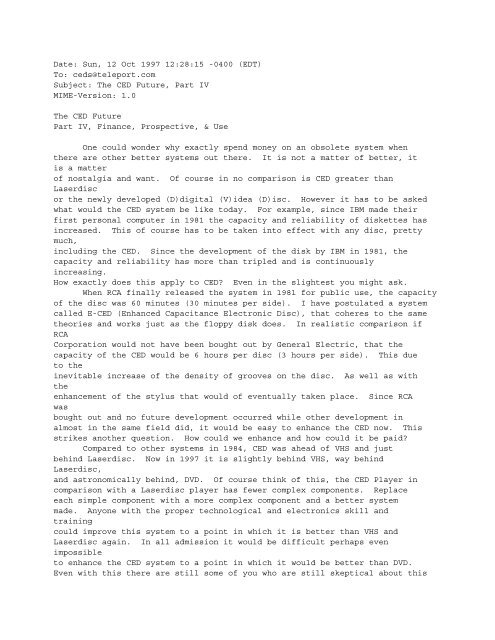Create successful ePaper yourself
Turn your PDF publications into a flip-book with our unique Google optimized e-Paper software.
Date: Sun, 12 Oct 1997 12:28:15 -0400 (EDT)<br />
To: ceds@teleport.com<br />
Subject: The <strong>CED</strong> Future, Part IV<br />
MIME-Version: 1.0<br />
The <strong>CED</strong> Future<br />
Part IV, Finance, Prospective, & Use<br />
One could wonder why exactly spend money on an obsolete system when<br />
there are other better systems out there. It is not a matter of better, it<br />
is a matter<br />
of nostalgia and want. Of course in no comparison is <strong>CED</strong> greater than<br />
Laserdisc<br />
or the newly developed (D)digital (V)idea (D)isc. However it has to be asked<br />
what would the <strong>CED</strong> system be like today. For example, since IBM made their<br />
first personal computer in 1981 the capacity and reliability of diskettes has<br />
increased. This of course has to be taken into effect with any disc, pretty<br />
much,<br />
including the <strong>CED</strong>. Since the development of the disk by IBM in 1981, the<br />
capacity and reliability has more than tripled and is continuously<br />
increasing.<br />
How exactly does this apply to <strong>CED</strong>? Even in the slightest you might ask.<br />
When RCA finally released the system in 1981 for public use, the capacity<br />
of the disc was 60 minutes (30 minutes per side). I have postulated a system<br />
called E-<strong>CED</strong> (Enhanced Capacitance Electronic Disc), that coheres to the same<br />
theories and works just as the floppy disk does. In realistic comparison if<br />
RCA<br />
Corporation would not have been bought out by General Electric, that the<br />
capacity of the <strong>CED</strong> would be 6 hours per disc (3 hours per side). This due<br />
to the<br />
inevitable increase of the density of grooves on the disc. As well as with<br />
the<br />
enhancement of the stylus that would of eventually taken place. Since RCA<br />
was<br />
bought out and no future development occurred while other development in<br />
almost in the same field did, it would be easy to enhance the <strong>CED</strong> now. This<br />
strikes another question. How could we enhance and how could it be paid?<br />
Compared to other systems in 1984, <strong>CED</strong> was ahead of VHS and just<br />
behind Laserdisc. Now in 1997 it is slightly behind VHS, way behind<br />
Laserdisc,<br />
and astronomically behind, DVD. Of course think of this, the <strong>CED</strong> Player in<br />
comparison with a Laserdisc player has fewer complex components. Replace<br />
each simple component with a more complex component and a better system<br />
made. Anyone with the proper technological and electronics skill and<br />
training<br />
could improve this system to a point in which it is better than VHS and<br />
Laserdisc again. In all admission it would be difficult perhaps even<br />
impossible<br />
to enhance the <strong>CED</strong> system to a point in which it would be better than DVD.<br />
Even with this there are still some of you who are still skeptical about this


